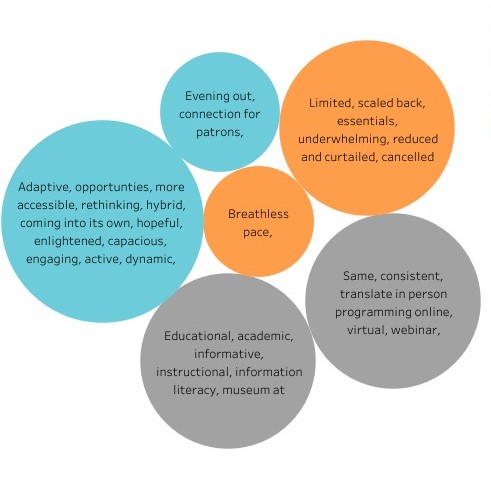The pandemic has been an historic moment as libraries everywhere pivoted to digital services to meet the needs of their public. Although the technology necessary to support such a paradigm shift has existed for years (Badia & Colosimo, 2013) it took the circumstances imposed by COVID-19 and social distancing measures to propel the transition to an online environment. Throughout quarantine, “[d]emand for online library services skyrocketed across [Canada], with expanded online programming and e-book spending” (Gold, 2020). Meanwhile, as students and white-collar workers adapted to remote working strategies, the concept of the “new normal” and the possibility of an emerging tele-everything-metaverse was pervasive.

In this vision of the future, experts in technology and communications speculate that large segments of the population may come to rely on digital connections for everything from work, health care and education to commerce, recreation and social activity (Anderson, Rainie, & Vogels 2021). Undoubtedly, some of the digital services offered by libraries will continue and expand beyond the pandemic. Now, with the end of lockdown measures coming into effect in many places, the long-term impacts of these adaptations may start to become more apparent.
Digital services offered by libraries throughout quarantine served an essential social function by ensuring public access to resources and user services. Contactless pickup made print materials accessible, while digitization and e-resources provided remote access to various collections. User services, such as virtual reference and remote instruction, and online programming, like workshops and webinars, kept people informed and connected. Increased access and convenience for some patrons, especially those who live in remote locations or face other barriers to accessing physical sites, are fundamental advantages of providing online services. During lockdown, these adaptive services also helped to alleviate the isolation many people experienced by providing continuity and a sense of community. The transition to an online environment has emphasized a need to invest in more digital infrastructure. However, during this transition, people with little or no access to technology or the internet may have been deprived entirely of any benefits. In a tele-everything world, the consequences of the digital divide and resulting social inequity will be heightened. Thus, beyond confinement, the library as a physical site and “third place” remains an important standard for offering access to resources as well as a space for community.

PERPSPECTIVES ON THE IMPACTS OF TRANSITIONING TO DIGITAL SERVICES
From January – April 2021 I was a practicum student at Rare Books, Osler, Art, & Archives (ROAAr) at the McGill Library conducting a study of digital outreach. I surveyed public programming offered by libraries, museums and community organizations, distributed an online questionnaire, and interviewed academic librarians involved in e-learning and digital outreach services. The responses provide some first-hand perspectives from information professionals on the advantages and disadvantages of various COVID-19 adaptive working strategies and user services (Lewis, 2021).
A majority (38%) emphasized consistency. Descriptors such as “museum at home”, “translate in person programming online”, “business as usual” and “service continuity” indicate an approach to providing online service that replicates the in-person experience. However, discussion during interviews revealed that transposing in-person services online is not necessarily a direct translation of the previous mode of service. Transitioning to a digital service model is a paradigm shift that will impact the way we work, learn, grow, and interact.
The remainder of responses summarizing organizations’ programming tones were split between pessimistic (27%) and optimistic (35%) takes on the transition, with optimism prevailing, slightly.

Ostensibly, pessimistic responses stemmed from the pressures induced by the unexpected and sudden demands of the shift. Descriptors such as “breathless pace”, “scattershot”, “ramshackle”, “hectic”, “barely treading water”, “limited”, “scaled back”, “diminished”, “sad”, and “lacklustre” implied some anxiety. Although a significant majority of respondents (92%) answered that they would pursue a hybrid model of programming post-pandemic, they also indicated in large measure that to continue they will need additional resources, such as digital tools, equipment, software, and more human resources. Resource expenditure (time, staffing, funds) necessitated by the transition was a major concern expressed by respondents to the questionnaire.

Other concerns about the transition to remote delivery of services in the long term included health and equity issues. Many participants in the survey indicated their concern about screen fatigue and loss of the ability to concentrate during tele-conferencing and webinars. Attention, information overload, and the ability to engage are rising challenges of a tele-mediated culture. Whether or not increased screen time is healthy, if it is an effective way to learn and interact, and its long-term impacts are still unknown. With regard to equity, access to technology and the internet will determine who can participate, while accessibility considerations and the conception of digital services will determine whether everyone can participate equally. Finally, many participants expressed a desire to return to on-site events. Human connection may be the most untranslatable and irreplaceable element missing from online programming. The loss of information, such as nonverbal cues, combined with technical issues, like time lag, can lead to frustrating and stilted interactions online. On the other hand, adjusting to communication in an online environment may be the tip of the iceberg of a broader social adaptation.
(right) Screenshot from online library workshop: Rare Stitches: Knitting Inspired by Illuminated Manuscripts with historian and knitter Kristen Howard held on Zoom, February 18, 2021. Howard, visible in the upper right hand corner, shares her screen with participants showing images of the process of developing a knitting pattern from a letter in an illuminated manuscript.

Optimistic responses included descriptors like “opportunities”, “rethinking”, “dynamic”, and “more accessible”. The primary advantage that emerged in the responses was the potential for greater access. Professionals recognized the opportunities that digital services provide for greater ease of use and convenience, for increased access for people in remote locations or with barriers to physical access, and for outreach and audience growth. The ability to experience and participate in programming across the globe also increases the potential for new relationships and collaboration. Many respondents also reported positive outcomes such as new skills acquired. This shows hopefulness towards the possibility that the challenges of digital service we face now will lead to long-term gains and positive evolution.
CONCLUSION
Libraries made a momentous pivot in March 2020, shifting most of their services online. Many professionals anticipate widespread adoption of a digital service model. While the transition reflects a broader trend towards the metaverse in other spheres of society, its immediate and long-term impacts remain to be seen. The crux of these changes for libraries is accessibility – both the gains and challenges – alongside the importance of digital equity. Maintaining the physical presence of the library is significant since it offers a means of bridging the digital divide. As libraries adapt, expanding their digital infrastructure and services, they will play a vital role in shaping the online environment into an inviting space where learning and sharing can flourish.
CONTRIBUTOR
Katherine Lewis
MISt McGill
WORKS CITED
Anderson, J., Rainie, L., & Vogels, E. (2021, February 18). Experts say the “new normal” in 2025 will be far more tech-driven, presenting more big challenges. Pew Research Center.
Badia, G. & Colosimo, A.L. (2013). Best practices for engaging users in a web conferencing environment. ASEE Annual Conference and Exposition, Conference Proceedings, Atlanta, Georgia.
Gold, K. (2020, July 28). How public libraries play a vital role in restoring the economy. Globe and Mail.
Klingbeil, C. (2020, March 25). Canadian libraries respond to COVID-19. Library Journal.
Lewis, K. (2021, April 12). Scanning GLAM: virtual outreach in pandemic times & beyond. Library Matters.
IMAGES
McGill ROAAr – Rare Books & Special Collections, Osler Library of the History of Medicine, Visual Arts Collection and McGill University Archives

